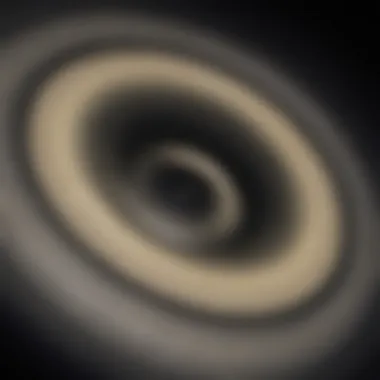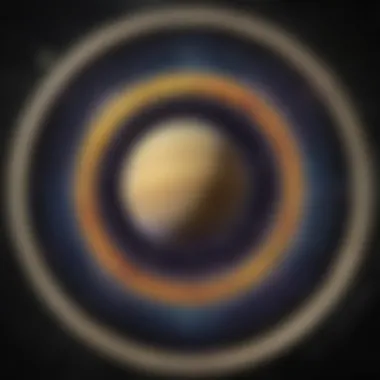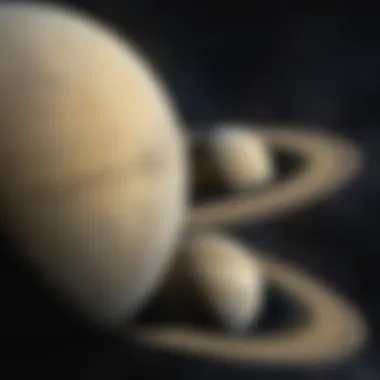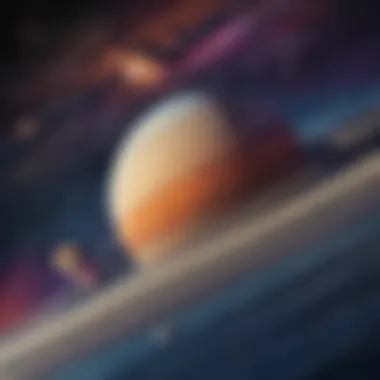Unveiling the Enigmatic Charms of Saturn: A Celestial Odyssey


Educational Fascination of Saturn
Saturn's enigmatic allure captivates the curious minds of all ages. As we embark on an enlightening journey through the cosmos, the riddles and revelations surrounding this gas giant spark our fascination and wonder. Let's delve into the mesmerizing realm of Saturn, the sixth planet from the sun in our celestial neighborhood.
The Mystique of Saturn
In the vast expanse of space, Saturn stands out with its striking rings encircling the planet like a majestic crown. These rings, composed of ice, rocks, and dust, add to Saturn's charm and mystery, inviting us to ponder the wonders of our universe. What secrets lie within these shimmering bands that have intrigued astronomers for centuries?
Saturn's Enigmatic Features
Among the solar system's planets, Saturn's unique characteristics set it apart as a gas giant. Its swirling storms, including the famous hexagonal cloud pattern at its north pole, mesmerize viewers and astound scientists with their intricate beauty and complexity. Understanding the mechanisms behind Saturn's weather systems offers a glimpse into the dynamic forces shaping this distant world.
Unraveling Saturn's Secrets
As we unravel the mysteries of Saturn, we encounter its diverse moons, each holding its own secrets and surprises. From Titan, with its dense atmosphere and ethane lakes, to Enceladus, with icy jets shooting into space, Saturn's moons provide a rich tapestry of exploration for scientists and dreamers alike. What do these moons reveal about the potential for life beyond Earth?
Conclusion: A Cosmic Odyssey
Introduction
Delve into the mesmerizing world that is Saturn, the illustrious sixth planet reigning in our solar system. As we embark on this extraordinary journey, we unravel the enigmatic characteristics and mysteries that shroud this colossal gas giant. It is within Saturn's realm that a treasure trove of intriguing facts and revelations await our eager exploration.
Overview of Saturn
Saturn's Position in the Solar System
Saturn holds its celestial throne as the second-largest planet in our galactic neighborhood. Nestled between Jupiter and Uranus, its strategic placement bestows upon it a pivotal role in the cosmic ballet of the solar system. This positioning not only amplifies Saturn's gravitational influence but also enriches our understanding of planetary dynamics and interactions. The sheer magnitude of Saturn's mass exerts a gravitational pull that orchestrates the intricate orbits of neighboring celestial bodies with finesse.
Physical Characteristics of Saturn
The physical allure of Saturn lies in its staggering size and distinctive features. Draped in a tapestry of gaseous layers, this gas giant boasts a mesmerizing array of hues and patterns. Saturn's most iconic attribute, its magnificent ring system, adds a celestial charm that sets it apart from its planetary counterparts. These rings, composed of icy particles and dust, encapsulate the planet in a dazzling display of cosmic beauty and scientific intrigue.
Significance of Studying Saturn
Scientific Importance
In the realm of astrophysics, Saturn emerges as a pivotal player in unlocking the mysteries of our solar system's formation and evolution. By delving into Saturn's composition, structure, and behaviors, scientists glean invaluable insights into the broader tapestry of cosmic phenomena. Exploring Saturn's intricate dynamics not only fuels scientific curiosity but also contributes to our profound understanding of planetary systems beyond our own.
Astrological Significance
Astrologically, Saturn holds a mythical status that transcends the realms of classical mythology. Embedded in ancient folklore as the symbol of discipline and maturity, Saturn's celestial dance influences astrological readings and interpretations. Its association with virtues such as responsibility and perseverance infuses astrological narratives with profound wisdom and guidance. Through the astrological lens, Saturn invites us to contemplate the cyclical nature of time and the transformative power of adversity and growth.
Rings of Saturn


When exploring Saturn, one cannot overlook the mesmerizing rings that encircle this majestic planet. Understanding the characteristics of Saturn's rings is essential in appreciating their beauty and scientific significance. These rings consist of countless particles ranging in size from tiny grains to large boulders, creating a spectacle that captivates astronomers and enthusiasts alike. By examining the intricate details of Saturn's rings, we gain insights into their composition, structure, and dynamics, offering valuable data for research and exploration purposes.
Characteristics of Saturn's Rings
The characteristics of Saturn's rings encompass a diverse array of features that differentiate each ring system. From their varying thickness to distinct compositions, Saturn's rings exhibit unique qualities that distinguish them from other ringed celestial bodies. Exploring the characteristics of these rings allows for a deeper understanding of their formation mechanisms and evolution over time. By elucidating the complexities of Saturn's ring systems, scientists can unravel the mysteries surrounding their origin and longevity, contributing to our knowledge of planetary ring dynamics.
Formation and Evolution of Rings
The formation and evolution of Saturn's rings present a captivating narrative of celestial processes at work. Factors such as gravitational interactions, collisions, and tidal forces have influenced the development and alterations of Saturn's ring systems throughout history. Studying the formation and evolution of these rings provides valuable information on the age of the rings, their future trajectory, and the external factors that shape their structure. By exploring the origin and transformation of Saturn's rings, we gain critical insights into the dynamic nature of planetary rings and their role in the broader context of planetary science and exploration.
Atmosphere and Weather Patterns
In this article, delving into the atmosphere and weather patterns of Saturn provides a crucial insight into understanding the overall nature of this intriguing gas giant. The study of Saturn's atmosphere is imperative for comprehending its atmospheric composition, dynamics, and interactions. By exploring the unique atmospheric conditions and weather patterns on Saturn, we can unlock a wealth of information regarding the planet's climate, behavior, and natural phenomena.
Atmospheric Conditions
Gases Present in Saturn's Atmosphere
The composition of gases in Saturn's atmosphere plays a pivotal role in shaping the planet's characteristics and behaviors. With elements such as hydrogen and helium dominating its atmosphere, Saturn exhibits a gaseous nature that distinguishes it from other planets. Understanding the abundance and distribution of these gases provides valuable insights into Saturn's formation, evolution, and overall atmospheric dynamics. The unique feature of Saturn's hydrogen- and helium-rich atmosphere contributes significantly to its immense size and low density, making it a compelling subject for scientific inquiry and exploration.
Weather Patterns on Saturn
Exploring the weather patterns on Saturn unveils a tapestry of complex atmospheric phenomena that influence the planet's climate and surface conditions. The intricate interplay of wind patterns, cloud formations, and atmospheric disturbances creates a dynamic weather system that is both fascinating and challenging to decipher. By studying the cyclical nature of Saturn's weather patterns, scientists can infer valuable information about the planet's atmospheric processes, seasonal changes, and meteorological phenomena. The unique feature of Saturn's ever-changing weather patterns provides a rich field for scientific investigation and enhances our understanding of planetary atmospheres.
Storms on Saturn
Overview of Saturn's Storms
Diving into the realm of Saturn's storms reveals a vibrant world of atmospheric disturbances that shape the planet's meteorological landscape. From massive cyclones to swirling clouds, Saturn's storms exhibit a diverse range of characteristics that showcase the planet's dynamic weather patterns. By examining the frequency, intensity, and duration of these storms, researchers can gain valuable insights into Saturn's atmospheric dynamics, energy transfer mechanisms, and climate feedback processes. The unique feature of Saturn's tumultuous storms offers a captivating lens through which to explore the complexities of planetary weather systems and their impacts on celestial bodies.
The Great White Spot Phenomenon
The phenomenon of the Great White Spot on Saturn represents a captivating spectacle of atmospheric upheaval and transformation. This rare occurrence, characterized by a large and bright atmospheric disturbance, offers a glimpse into the planet's tumultuous weather dynamics and climatic phenomena. By studying the origins, behavior, and implications of the Great White Spot phenomenon, scientists can unravel mysteries surrounding Saturn's atmospheric processes, storm formation mechanisms, and long-term climate trends. The unique feature of the Great White Spot phenomenon provides a fascinating avenue for in-depth research and exploration into the enigmatic world of Saturn's atmospheric phenomena.
Magnetic Field and Magnetosphere
To truly grasp the essence of Saturn, one must delve into the complexities of its magnetic field and magnetosphere, pivotal elements that shape the planet's interaction with its surroundings. Understanding the magnetic field and magnetosphere of Saturn offers a glimpse into the intricate dynamics at play in this celestial body. By unraveling the mysteries surrounding these phenomena, scientists and researchers can gain valuable insights into the broader cosmic environment and the functioning of gas giants like Saturn on a fundamental level. The magnetic field and magnetosphere of Saturn play a crucial role in influencing various atmospheric and space weather patterns, making them subjects of great importance in the realm of planetary science.
Characteristics of Saturn's Magnetosphere
Size and Shape of the Magnetosphere
Delving into the size and shape of Saturn's magnetosphere provides a window into the vast extent of its influence in the solar system. The unique configuration of Saturn's magnetosphere, characterized by its expansive reach and distinct morphology, distinguishes it from other planetary magnetic fields. Its sheer size and dynamic shape contribute significantly to the way Saturn interacts with solar wind and cosmic radiation, shielding its moons and rings from potentially harmful particles.


Interaction with Solar Wind
The interaction between Saturn's magnetosphere and the solar wind sheds light on the interplay between different celestial bodies in our cosmic neighborhood. Saturn's magnetosphere acts as a protective barrier against the solar wind, deflecting charged particles and shaping the behavior of plasma in its vicinity. This interaction not only influences Saturn's atmospheric phenomena but also plays a vital role in shaping the broader dynamics of the solar system. Studying the intricate dance between Saturn's magnetosphere and solar wind provides invaluable insights into the larger cosmic ecosystem and the forces at play in our corner of the universe.
Magnetic Field of Saturn
Comparison to Earth's Magnetic Field
Drawing comparisons between Saturn's magnetic field and that of Earth offers a unique perspective on the diversity of magnetic phenomena in the solar system. Contrasting the strengths, orientations, and effects of these magnetic fields highlights the variability and complexity of planetary magnetism. Saturn's magnetic field, with its own set of characteristics and behaviors, presents a fascinating subject for scientific inquiry and exploration, enriching our understanding of magnetic fields beyond our home planet.
Impact on Saturn's Environment
Exploring the impact of Saturn's magnetic field on its environment unveils the interconnectedness between celestial magnetism and planetary dynamics. Saturn's magnetic field exerts a profound influence on the charged particle distribution, auroral processes, and atmospheric dynamics of the planet, shaping its overall environment. By examining how Saturn's magnetic field interacts with its surroundings, scientists can unravel the intricate mechanisms governing the interactions between magnetic fields and planetary atmospheres, contributing to a deeper comprehension of the fundamental processes shaping our solar system.
Exploration and Missions
Exploration and Missions play a pivotal role in our quest to unravel the mysteries of Saturn. By delving deep into NASA missions dedicated to the exploration of Saturn, we gain invaluable insights into this enigmatic gas giant. These missions serve as the forefront of our scientific endeavors, aiming to uncover the secrets of Saturn's rings, moons, and atmospheric conditions. They provide data that aids in understanding the formation and evolution of this sixth planet from the Sun.
NASA Missions to Saturn
Cassini-Huygens Mission
The Cassini-Huygens Mission stands out as a pioneering exploration endeavor focused on Saturn. It involved the Cassini spacecraft and the Huygens probe, jointly developed by NASA, the European Space Agency (ESA), and the Italian Space Agency (ASI). This mission provided a comprehensive analysis of Saturn's rings, moons, and magnetosphere, significantly advancing our knowledge of this celestial body. The unique feature of the mission was its extended duration, enabling a prolonged study of Saturn and its unique characteristics.
Insights from Voyager Missions
The Voyager Missions offered unparalleled insights into the outer solar system, including Saturn. These missions provided crucial data on the planet's atmosphere, rings, and moons, enhancing our understanding of Saturn's composition and dynamics. Voyager missions paved the way for subsequent explorations and contributed significantly to our knowledge of the gas giants in our solar system. Their ability to capture detailed images and data from close proximity to Saturn added to their scientific relevance and impact in expanding our knowledge of the ringed planet.
Key Discoveries by Spacecraft
Probing Saturn's Moons
Probing Saturn's moons has yielded remarkable discoveries about these enigmatic satellites. By studying Titan, Enceladus, and other moons of Saturn, spacecraft have uncovered evidence of subsurface oceans, geysers, and potential habitats for extraterrestrial life. This exploration has shed light on the diversity and complexity of Saturn's moon system, providing valuable information for future missions and scientific research. The unique feature of this exploration lies in its potential to discover habitable environments beyond Earth.
Investigating Saturn's Rings
The investigation of Saturn's rings has been a focal point of spacecraft missions, aiming to elucidate their composition, evolution, and dynamics. By conducting detailed analyses of the ring particles and their interactions, spacecraft have revealed intricate details about the formation processes and stability of Saturn's rings. This exploration has highlighted the role of moons in sculpting the ring patterns and has provided insights into the underlying physics governing ring dynamics. The unique feature of investigating Saturn's rings lies in its contribution to planetary formation theories and the study of celestial ring systems.
Moons of Saturn
In this article delving into the fascinating facts about Saturn, an in-depth exploration of the Moons of Saturn sheds light on significant aspects. The moons of Saturn play a crucial role in enriching our understanding of this gas giant and its unique celestial environment. With a diverse array of moons orbiting Saturn, each with its own distinctive characteristics and mysteries, studying these natural satellites provides valuable insights into the dynamics of Saturn's moon system.
Diverse Moon System


Titan: Saturn's Largest Moon
Titan, Saturn's largest moon, stands out as a key focal point in unraveling the mysteries of Saturn. Known for its thick atmosphere and organic-rich chemistry, Titan offers a fascinating landscape for scientific exploration. Its methane lakes and rivers, along with hydrocarbon seas, present a unique setting for studying potential extraterrestrial environments and understanding prebiotic chemistry. The characteristic haze surrounding Titan adds to its enigmatic allure, making it a compelling subject for comprehensive study within this article.
- Unique Feature: Titan's atmosphere resembles early Earth conditions, offering insights into our planet's past.
- Advantages: Studying Titan aids in understanding planetary evolution and the potential for life beyond Earth.
Enceladus: Geysers and Subsurface Ocean
Enceladus, with its geysers and subsurface ocean, holds a significant role in the exploration of Saturn's moons. The geysers on Enceladus provide evidence of a subsurface ocean beneath its icy crust, raising intriguing questions about the possibility of habitable environments beyond Earth. The presence of liquid water and organic molecules within Enceladus points towards essential conditions that could support microbial life. Delving into the mysteries of this moon contributes valuable data to this article's overarching narrative.
- Unique Feature: Enceladus showcases active plumes erupting from its surface, indicating subsurface oceanic activity.
- Advantages: Exploring Enceladus offers insights into potential habitability and astrobiological considerations.
Moon Exploration Missions
Exploring Titan's Surface
The exploration of Titan's surface represents a critical endeavor in understanding the dynamics of Saturn's largest moon. By studying the surface features, including the hydrocarbon seas and terrain compositions, scientists gain valuable knowledge about the geological processes at play on Titan. Investigating Titan's surface helps unlock the mysteries of this enigmatic moon, offering crucial data for comprehensive analysis.
- Unique Feature: Titan's surface exhibits vast, dark regions speculated to be seas or lakes of liquid methane and ethane.
- Advantages: Exploring Titan's surface enables a deeper understanding of planetary geology and potential habitability.
Searching for Signs of Life
The quest for signs of life on Saturn's moons, including Enceladus and Titan, forms a pivotal component of space exploration missions. Investigating biosignatures and biomarkers within these celestial bodies could provide groundbreaking insights into the existence of life beyond Earth. By focusing on the search for signs of life, space agencies aim to push the boundaries of astrobiology and unravel the mysteries of potential alien life within our solar system.
- Unique Feature: Searching for signs of life on Saturn's moons involves sophisticated instrumentation to detect potential microbial activity.
- Advantages: Exploring the possibility of life on Saturn's moons broadens our understanding of astrobiology and the conditions conducive to life in the cosmos.
Comparative Analysis
In the realm of exploring the enigmatic gas giant Saturn, conducting a comprehensive comparative analysis holds significant value. By juxtaposing Saturn with other planets, particularly its celestial neighbor Jupiter, we gain crucial insights into the unique attributes and distinctions of Saturn in the vast expanse of our solar system. This comparative lens allows us to delve deeper into the mysteries shrouding Saturn's formation, composition, and atmospheric conditions, unravelling the complexities of this captivating gas giant. Comparing Saturn to Jupiter helps us appreciate the diverse planetary characteristics present in our cosmic neighborhood and underscores Saturn's unparalleled allure.
Contrasting Saturn with Other Planets
Comparing Saturn to Jupiter
Delving into the comparative study between Saturn and Jupiter reveals compelling facets of these gas giants. Saturn, known for its stunning ring system and distinct golden hue, contrasts Jupiter's massive size and turbulent atmosphere. While Jupiter boasts a colossal magnetic field and a plethora of moons, Saturn surprises with its intricate ring structure and less dense composition. This in-depth comparison not only enriches our understanding of planetary diversity but also sheds light on the evolutionary trajectories and celestial dynamics shaping these neighboring giants. By juxtaposing Saturn with Jupiter, we decipher the nuanced tapestry of planetary wonders that adorn our solar system, fostering a deeper appreciation for the enigmatic beauty of Saturn.
Unique Features of Saturn
Exploring the unique features of Saturn unveils a tapestry of mesmerizing elements that set this gas giant apart from its planetary counterparts. Saturn's iconic ring system, composed of ice particles and rocky debris, stands as a celestial marvel that defies conventional planetary norms. Additionally, Saturn's hexagonal polar storm and myriad of moons, including the intriguing Titan and Enceladus, captivate astronomers and enthusiasts alike with their otherworldly charm. The distinct features of Saturn offer a window into the dynamics of planetary formation and evolution, showcasing the boundless wonders that populate our cosmic landscape. By spotlighting Saturn's unique attributes, we embark on a journey of cosmic discovery, unlocking the secrets of this captivating gas giant that reigns supreme in the night sky.
Saturn in Mythology and Culture
Historical References to Saturn
Tracing the historical references to Saturn in mythology and culture adds a layer of mystique to the enigmatic gas giant. From ancient civilizations to modern folklore, Saturn emerges as a symbol of time, harvest, and cosmic order, weaving through the celestial tapestry of human imagination. The mythological associations with Saturn, often linked to the god of agriculture and abundance, showcase a universal reverence for the celestial body that reigns supreme in the planetary pantheon. By exploring Saturn's historical symbolism, we uncover the deep-rooted connections between the heavens and earthly realms, unravelling the timeless allure of Saturn in the annals of human culture.
Modern Interpretations
In contemporary times, Saturn's significance transcends ancient myths, sparking modern interpretations that blend science, mysticism, and cultural symbolism. Studying Saturn through a modern lens illuminates its role as a celestial muse, inspiring art, literature, and scientific inquiry. Modern interpretations of Saturn delve into its ring dynamics, moon interactions, and planetary mysteries, fueling a renaissance of cosmic exploration and creative expression. By delving into the modern discourse surrounding Saturn, we bridge the gap between ancient myths and cutting-edge discoveries, forging a holistic understanding of Saturn's enduring legacy in human culture and scientific curiosity.















